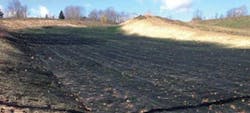About the author:
Jill Pack is erosion control product manager for Tensar North American Green. Pack can be reached at [email protected] or 800.772.2040.
When Hurricane Irene churned to shore, it left a path of destruction across 10 states and an estimated $7 billion of damages in its wake. Residents of New York’s Greene County, located in the state’s scenic Northern Catskills, were some of the 3 million people affected by the devastating storm. When the storm passed, residents of Windham, N.Y., faced power outages, flooding, downed trees and significant damage to a series of vital dams.
The earthen spillways at the 40-year-old Maplecrest, Nauvoo and Mitchell Hollow Dams were no match for the torrential downstream flooding spurred by Irene. River flooding records were broken in 26 rivers, and despite its eventual downgrade to a tropical storm, Irene left severe erosion in its wake when it hit the dams. The heavy rainfall also affected the emergency spillways built for the three flood control dams that serve the Batavia Kill (River) Watershed, a system that supports area residents, recreation and local industry.
In an effort to repair the immediate damage, Fastracs Excavating Inc. carried out temporary stabilization repairs throughout the spillway. However, a long-term solution was needed to sustain the area. With this in mind, the Batavia Kill Watershed District scheduled permanent repair work for the fall of 2012 to address the damage.
Before repairs could begin, the nature of the site and its surrounding area needed to be taken into consideration. Because the dams were surrounded by farmland, the district preferred a reinforced, vegetated solution—and timing was critical.
Creating a Strong Foundation
Local Tensar North American Green representatives from the northeast U.S. region called on project engineers from C.T. Male Associates to introduce the company’s erosion control products in an effort to improve the ravaged spillway. Given the district’s objectives, as well as the state design requirements, the engineers suggested using the VMax P550 permanent turf reinforcement mat (TRM) to address the erosion control issues.
“The spillways needed a stand of vegetation in advance of the rainy season and snow,” said Mark Grady, marketing representative for E.J. Prescott Inc., an area distributor for Tensar North American Green erosion control systems. “The VMax P550 TRM’s matrix opening allows for fast vegetation growth through the mat, providing both an anchor for vegetation and the ability to filter fines during inclement weather.”
This particular TRM system combines 3-D matting with fiber matrix material to offer rigorous erosion protection, vegetation establishment and reinforcement properties. The severe storm damage and critical weather experienced in the region called for a product with these strengths.
Test reports were presented to the project engineers to showcase the TRM’s performance and proven track record and its success at enhancing grass growth. “Its ability to establish vegetation was the determining factor. Additionally, it did not require soil infilling to achieve maximum performance values, which saved the contractor and district time and money,” said Joe Koziell, Tensar North American Green’s northeast U.S. region manager for erosion control.
Big Installation
Prior to installation, the sites were seeded with a three-variety blend of fescue grass seed, and although both early winter and spring frosts delayed some germination, the grass grew.
“In areas where seeding took hold over late summer and early fall, the grass is looking great,” said Thomas Hoyt, the town of Windham’s highway and water superintendent and contract officer for the watershed district.
Fastracs’ crews completed the four installations of the TRM system in the fall of 2012 over a five-week period, including interruptions due to periods of cold weather.
Altogether, 35,000 sq yards of product, covering almost 7 acres of graded surface with a 3-in. layer of native topsoil, were placed. Jerry Paschal, Fastracs project manager, scheduled 12- to 16-man crews for the installation. Paschal indicated that the rolls of TRM were easy to handle and unroll, but that the heavy compacted clay surface posed a challenge for stapling and securing the mats. In response, the crew devised a stapling tool to overcome surface resistance.
Despite more inclement weather in the Northern Catskills, including a 50-year rain event in September 2012, Hoyt stated that the TRMs are performing to expectations.
Download: Here


